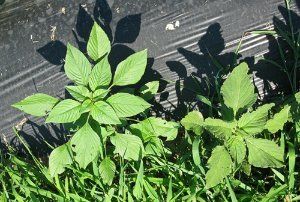Description: Redroot Pigweed, scientifically known as Amaranthus retroflexus, is an annual broadleaf weed belonging to the Amaranthaceae family. Commonly referred to as Amaranth or Pigweed, this plant is recognized for its rapid growth, upright stature, and distinctive reddish taproot. Native to North America, Redroot Pigweed has become a widespread and common weed in various regions globally.
Habitat and Distribution: Redroot Pigweed thrives in disturbed areas, cultivated fields, gardens, and along roadsides. It prefers full sun and can adapt to a variety of soil types. Its ability to produce vast quantities of seeds contributes to its ubiquity in both agricultural and non-agricultural landscapes.
Physical Features:
- Stems: Redroot Pigweed produces erect, branching stems that can reach heights of up to several feet. The stems are often reddish in color.
- Leaves: The leaves are ovate to diamond-shaped, with a distinctive reddish-purple spot on the leaves' lower surface. The leaf margins are typically toothed.
- Flowers: Small, greenish flowers are arranged in dense, terminal spikes. The flowering spikes contribute to the plant's overall height and are a key characteristic.
Ecological Impact:
Redroot Pigweed can have both positive and negative ecological impacts:
- Soil Improvement: The taproot of Redroot Pigweed has been known to penetrate compacted soils, contributing to soil aeration.
- Competition with Crops: As a prolific seed producer, Redroot Pigweed can compete with crops for nutrients, water, and sunlight, impacting agricultural yields.
Concerns and Challenges:
- Competitive Weed: Redroot Pigweed is a highly competitive weed in agricultural settings, where it can reduce crop yields if not properly managed.
Control and Management:
Cultural Practices:
- Crop Rotation: Implementing diverse crop rotations can disrupt the life cycle of Redroot Pigweed and reduce its impact on specific crops.
- Cover Crops: Planting cover crops during fallow periods can help suppress the growth of Redroot Pigweed and prevent soil erosion.
Mechanical Control:
- Hand Pulling: Hand pulling is effective for small infestations. It's important to remove the entire plant, including the taproot, to prevent regrowth.
- Mowing: Regular mowing can prevent Redroot Pigweed from reaching maturity and producing seeds. However, mowing alone may not eliminate established plants.
Cultivation Practices:
- Tillage: Proper tillage practices can disrupt the growth of Redroot Pigweed. However, excessive or improper tillage may lead to soil erosion and other ecological issues.
Chemical Control:
- Herbicides: Selective herbicides labeled for broadleaf weed control can be applied to manage Redroot Pigweed in agricultural settings. Herbicide choice should consider crop safety and resistance management.
Preventing Spread:
- Seed Management: Regularly monitor and manage fields to prevent Redroot Pigweed from producing and dispersing seeds. Early detection is crucial. Implementing proper cleaning procedures for equipment can help prevent the unintentional spread of Redroot Pigweed seeds.
- Integrated Weed Management: Adopting an integrated approach that combines cultural, mechanical, and chemical control methods can be the most effective strategy for managing Redroot Pigweed.
- Awareness and Education: Educating farmers and land managers about the identification, ecology, and control measures of Redroot Pigweed is essential for effective weed management.
In conclusion, Redroot Pigweed poses challenges in both agricultural and non-agricultural settings due to its competitive nature and prolific seed production. A comprehensive approach that combines cultural practices, mechanical control, and judicious herbicide use is crucial for effectively managing Redroot Pigweed and preventing its widespread impact on crops and ecosystems.



